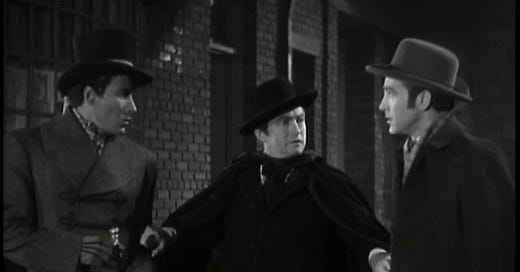Reeling Backward: The Mystery of Edwin Drood (1935)
Dickens' final, unfinished novel was turned into a dark, brooding horror-adjacent film about an uncle who covets his nephew's fiancee.
You can see the inherit challenges in adapting “The Mystery of Edwin Drood,” based on Charles Dickens’ final novel. He actually passed away with the book only half finished, keeping with his long habit of publishing his works in serial form in magazines. Subsequent writers and the filmmakers were able to piece the intended ending together from his letters and such.
It’s also interesting that the title refers to a secondary character who disappears halfway through the movie. Claude Rains is really the main character as John Jasper, Drood’s uncle, an upstanding church choirmaster who is secretly addicted to opium. Though it’s a curiously reactive role, operating more as the locus around which other characters revolve rather than the primary driver of the plot.
Directed by Stuart Walker from a screenplay by Leopold Atlas and John L. Balderston, “Drood” operates as a dark whodunit with some elements of both horror and romance. It’s notable for its challenging subject matter, including opium use and what is essentially a love quadrangle, with Jasper coveting the fiancee of his nephew, whom he calls Ned (David Manners), Rosa Bud (Heather Angel), his former music student.
As the story opens, Rosa and Edwin, both orphans coming of age, have been betrothed essentially from birth. They have a strong relationship, but it is closer to siblings than passionate lovers. Jasper sort of hangs around their charming city of Cloisterham (pronounced by the locals as “cloy-strum”) pining for her but unwilling to act. Jasper essentially raised Ned, despite being only age 34 to his 21, while Rosa has been brought up in a strict girls’ secondary school.
Things are shaken up by the arrival from British Ceylon (Sri Lanka) of Neville Landless (Douglass Montgomery) and his sister, Helna (Valerie Hobson). She joins the same school as Rosa and they become fast friends. Neville is tutored by Rev. Crisparkle (Francis L. Sullivan), a close friend of Jasper.
Neville takes an instant shine to Rosa, and a similarly timed dislike to Edwin — the former prompting the latter, no doubt. Neville warns Crisparkle that he has a violent temper, and indeed during a disagreement about Rosa over drinks at Jasper’s, he briefly snatches up a knife and threatens Edwin with it… before backing down.
This episode apparently plants the seed in Jasper’s head to find a way to do away with Edwin while casting the blame on the volatile Neville. There’s also an element of racial animosity, as Neville is dark-skinned and a number of comments are made about his need to act in a more cool British manner.
(In keeping with practices of the time, the white actor wears a bit of tinctured makeup. Curiously, his sister is not similar adorned.)
There’s a long sequence of Jasper exploring the local crypts under the church with the help of the compliant, drunken gravekeeper, Durdles (Forrester Harvey), which gives him the idea to use quicklime to decompose his nephew’s body and stick it in one of the empty graves.
Jasper tries to pin the disappearance of Edwin on Neville, though he’s only able to get as far as casting enough suspicion to darken his reputation around town. Six months go by, during which time Rosa rejects his protestations of love and Jasper returns to his opium habit.
Around this time an old man named Dick Datchery arrives in town and starts poking around into the mystery. It’s eventually revealed that this is Neville himself attempting to prove his innocence, somehow having acquired all sorts of skills at legerdemain, not to mention a lot of money he throws around for bribes and such.
It’s a well-made picture with excellent production values. I think its biggest failing is keeping Jasper’s character at such a far remove that we never feel like we understand his motivations for committing such a horrendous crime.
I guess this is so because the studio wanted to keep the titular mystery well-kept until the end. Though it’s not hard to guess from the way Jasper skulks about and the super creeper vibes he’s constantly throwing Rosa’s way. In one scene while he accompanies her singing on piano, she bursts into tears just based on the covetous gaze he casts upon her.
Rains was as fine an actor as there was at that age, and we saw him play well in other roles the outer trappings of a man with a tortured inner soul — probably most notably in “Notorious.” But the way the film is structured he doesn’t get much in the way of chances to depict why Jasper is so smitten with Rosa that he’s willing to kill.
It’s a classic show, don’t tell, vexation.
Probably his best scene is one where Rosa’s guardian, the businesslike Mr. Grewgious (Walter Kingsford), reveals to Jasper that Edwin and Rosa broke off their engagement the day before he disappeared. Jasper falls to the ground in shock — a far more emotive display than he put on when his nephew disappeared — because he realizes he didn’t have to murder Ned to remove him as a romantic competitor.
Of course, that still would have left Neville in the way. But if you’re willing to kill one, why not two?
The story ends on a rather conventional note, including a brawl between Neville in his Datchery disguise and Jasper, and a sacrificial leap from the church belfry with all the town’s officials in pursuit. The final scene is an incongruously happy marriage between Neville and Rosa… in the same church where the dastardly murder and suicide took place!
Who knows if “The Mystery of Edwin Drood” would have turned out a better movie if we had the second half the book to base it on. My guess is Dickens would’ve wound the screws a little tighter.





